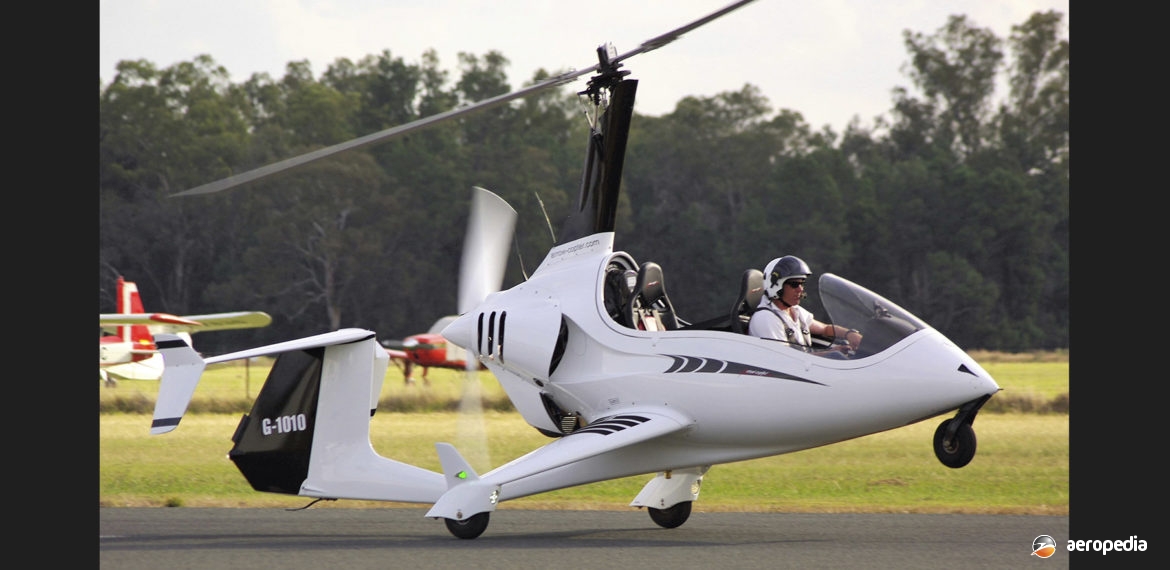Photograph:
FD Composites ArrowCopter AC-10 G-1010 at (c/n 53973) Temora, NSW in April 2012 (David C Eyre)
Country of origin:
Austria
Description:
Two-seat light sport gyrocopter
Power Plant:
One 75 kw (100 hp) Rotax 912S four-cylinder horizontally-opposed liquid-and-air-cooled engine
Specifications:
- [AC-10]
- Rotor diameter: 8.4 m (27 ft 6 in)
- Fuselage length: 5.57 m (18 ft 3 in)
- Width: 2.45 m (6 ft 6 in)
- Max speed: 200 km/h (124 mph)
- Max cruising speed: 165 km/h (102 mph)
- Minimum speed: 30 km/h (18.6 mph)
- Fuel capacity: 70 litres (15.4 Imp gals)
- Empty weight: 261 kg (575 lb)
- Loaded weight: 600 kg (1,322 lb)
History:
The FD Composites ArrowCopter was a two-seat high-performance gyrocopter produced in Austria to United Kingdom construction standard Section T CAP 643 which permitted its construction up to a maximum take-off weight (MTOW) of 600 kg (1,322 lb) and, in the ultralight class in Germany and other countries, up to a maximum weight of 450 kg (990 lb).
The ArrowCopter was produced in an Autoclav production technique by FD Composites GmbH of Zeillern, the prototype OE-VXF flying for the first time in Austria in 2008. It could be obtained with open cockpits or fully enclosed. It had an ergonomically designed cockpit and an enclosed engine exhaust system to reduce noise. An RFID chip was integrated in the aircraft and provided access to all manufacturing data, such as serial number, lot number and optional equipment.
A variety of engines was available. Initial aircraft had the 75 kw (100 hp) Rotax 912S with the 90 kw (120 hp) Rotax 914 turbocharged unit as an option. The manufacturer announced that it expected to offer the BMW R1.2 unit which provided up to 101 kw (135hp) in the future. The Model AC-20 had the Rotax 914 engine and had a rotor diameter of 8.5 m (27 ft 11 in), a length of 5.8 m (19 ft), a max speed of 195 km/h (121 mph), an empty weight of 350 kg (772 lb) and a loaded weight of 560 kg (1,235 lb).
The aircraft had high torsional and flexional stiffness for crash protection, using carbon fibre materials in a monocoque construction. The fuel tanks were located in the winglets and had a total capacity of 70 litres (15.4 Imp gals). Extra optional tanks were available. Differential braking was provided by toe-operated units. The tricycle undercarriage had a 2,45 m (8 ft) wide track and the aircraft had a low centre of gravity. In the cockpit, when enclosed, there was an integrated air circulating system and there was room for stowage of luggage.
First aircraft of the type seen in this area was G-1010 (c/n 53973) imported by the Australian distributors, AirCopter Australia of Gandaroo, NSW. It was demonstrated at Natfly 2012, being a Model AC-10. This aircraft (G-1010) was damaged when it made a forced landing in the Gandaroo area in February 2012 following the breaking up of the propeller in the air.
A Model AC-20 was registered as ZK-RBV (c/n 039 – ex N713TX) to Lange Enterprises of Dunedin, NZ on 20 January 2016.

